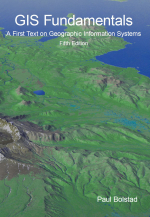Добрый день, Коллеги. Важное сообщение, просьба принять участие. Музей Ферсмана ищет помощь для реставрационных работ в помещении. Подробности по ссылке
GIS fundamentals. A first text on geographic information systems / Основы ГИС. Первый текст по географическим информационным системам
Geography has always been important to humans. Stone-age hunters anticipated the location of their quarry, early explorers lived or died by their knowledge of geography, and current societies work and play based on their understanding of who belongs where. Applied geography, in the form of maps and spatial information, has served discovery, planning, cooperation, and conflict for at least the past 3000 years (Figure 1-1). Maps are among the most beautiful and useful documents of human civilization.
Most often our geographic knowledge is applied to routine tasks, such as puzzling a route in an unfamiliar town or searching for the nearest diner. Spatial information has a greater impact on our lives than we realize by helping us produce the food we eat, the energy we burn, the clothes we wear, and the diversions we enjoy. Because spatial information is so important, we have developed tools called geographic information systems (GIS) to aid us with geographic knowledge. A GIS helps us gather and use spatial data (we will use the abbreviation GIS to refer to both singular, system, and plural, systems). Some GIS components are purely technological; these include space-age data collectors, advanced communications networks, and sophisticated computing. Other GIS components are very simple, for example, a pencil and paper used to field-verify a map. As with many aspects of life in the last five decades, how we gather and use spatial data has been profoundly altered by modern electronics, and GIS software and hardware are primary examples of these technological developments. The capture and treatment of spatial data has accelerated over the past three decades, and continues to evolve. Key to all definitions of a GIS are “where” and “what.” GIS and spatial analyses are concerned with the absolute and relative location of features (the “where”), as well as the properties and attributes of those features (the “what”). The locations of important spatial objects such as rivers and streams may be recorded, and also their size, flow rate, or water quality. Indeed, these attributes often depend on the spatialarrangement of important features, such as land use above or adjacent to streams. A GIS aids in the analysis and display of these spatial relationships. <...>




